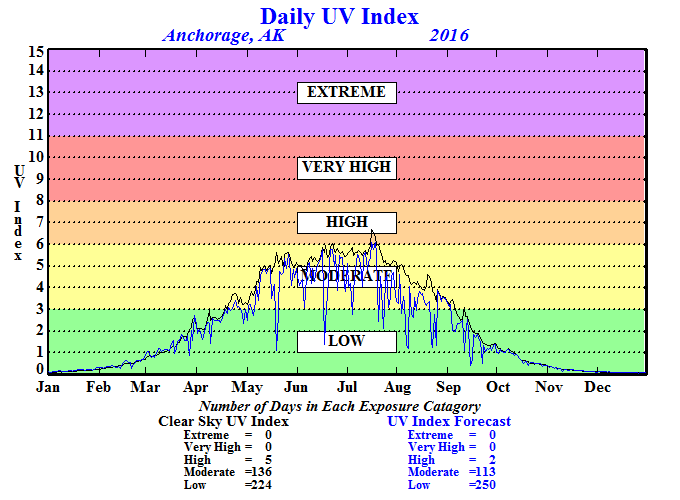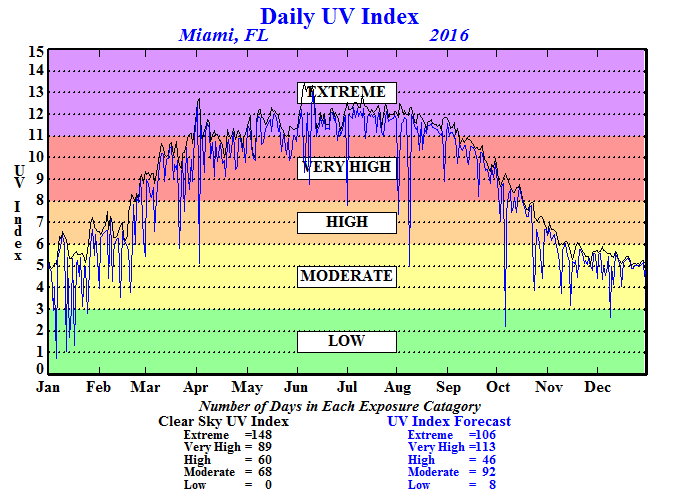Post by Babu on Feb 16, 2021 6:10:43 GMT -5
Apparently the UV Index is measured against a horizontal plane. This means that to get the actual direct UV Index of the sun you have to divide the UVI by the sinus of the solar elevation angle. If the UV index is 5 with a solar angle of 45 degrees, that's actually the exact same UV strength as 6.6 UVI at a 70 degree sun angle. Let's say you're standing up and wearing swimming trunks and nothing else. In that case, a typical 45 degree sun is going to expose you to more total (direct) UV radiation than a typical 70 degree sun, since the actual difference in UV intensity isn't as high as the UVI would suggest. Since a person standing up is significantly more vertical than horizontal, the small difference in UV intensity will be outweighed by more of the body facing the sun at lower sun angles. Of course, in real scenarios, indirect radiation coming from all over the sky as well as the albedo off the ground will play a large roll as well, working to negate the significance of the direct radiation.
However, the fact that UVI is measured against a horizontal plane does per definition mean that the index is vastly under-valued for lower sun angles. 30 degree angles receive only half the actual UVI, and 45 degree angles 71%, whereas already at 70 degrees the figure is 94%, almost negligible.
I'll pick a real world example to illustrate this.
Today the UVI in the Swiss alps at 2.2km altitude is 2.6 with a sun angle of 31 degrees. Tomorrow in Alexandria, Egypt the UVI is 4.4 with a 47 degree sun angle. You'd see that and you'd go "Alright, so despite the Swiss alps being so high, Alexandria still has a 70% stronger sun. Maybe with snow in the Alps they're about the same". But when accounting for the sun angle, the Alps gets an actual direct-UVI value of 5.0 whereas Alexandria gets 6.0 respectively. The sun is still stronger in Alexandria, but only by 19% as opposed to the 70% the horizontal UVI suggested. But if we assume a 80% increase from the snow, suddenly the alps gets a value of 9.1, a 51% increase over Alexandra. If we then take a look at the UV radiation hitting your forehead when upright, the Swiss alps gets a value of 7.8 direct-UVI hitting your forehead with snow or 4.3 direct-UVI snow not included, vs only 4.1 in Alexandria.
So despite the UV index being 70% higher in Alexandria, the UV radiation hitting your face (we're assuming your face is perfectly vertical to the ground) is actually 5% stronger in the Swiss alps than in Alexiandria, even when the snow isn't even included, or 84% stronger if we assume a 80% albedo.
However, the fact that UVI is measured against a horizontal plane does per definition mean that the index is vastly under-valued for lower sun angles. 30 degree angles receive only half the actual UVI, and 45 degree angles 71%, whereas already at 70 degrees the figure is 94%, almost negligible.
I'll pick a real world example to illustrate this.
Today the UVI in the Swiss alps at 2.2km altitude is 2.6 with a sun angle of 31 degrees. Tomorrow in Alexandria, Egypt the UVI is 4.4 with a 47 degree sun angle. You'd see that and you'd go "Alright, so despite the Swiss alps being so high, Alexandria still has a 70% stronger sun. Maybe with snow in the Alps they're about the same". But when accounting for the sun angle, the Alps gets an actual direct-UVI value of 5.0 whereas Alexandria gets 6.0 respectively. The sun is still stronger in Alexandria, but only by 19% as opposed to the 70% the horizontal UVI suggested. But if we assume a 80% increase from the snow, suddenly the alps gets a value of 9.1, a 51% increase over Alexandra. If we then take a look at the UV radiation hitting your forehead when upright, the Swiss alps gets a value of 7.8 direct-UVI hitting your forehead with snow or 4.3 direct-UVI snow not included, vs only 4.1 in Alexandria.
So despite the UV index being 70% higher in Alexandria, the UV radiation hitting your face (we're assuming your face is perfectly vertical to the ground) is actually 5% stronger in the Swiss alps than in Alexiandria, even when the snow isn't even included, or 84% stronger if we assume a 80% albedo.



